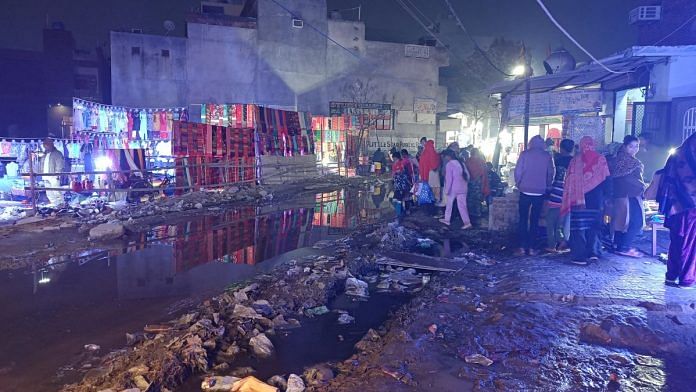Delhi/Moradabad: On a chilly January evening, Aarti Kumari got down from the tempo in Delhi’s Chauhan Patti village. Balancing a bag full of vegetables, she attempted to jump over the drain near her house. Over the months, she has developed a long jumper’s skill for her daily commute. Except this time, the 32-year-old lost balance and landed straight into the filth.
This wouldn’t have been unusual anywhere else in India, except that her neighbourhood is part of PM Narendra Modi’s flagship Saansad Adarsh Gram Yojana (SAGY), also known as the PM model village programme. And her village only reflects the larger problem with this programme – tardy and patchy implementation. This ‘adopt-a-village’ programme has sagged under questions of jurisdiction confusion and lack of budget, MPs’ apathy.
With her clothes soiled and her purchase lying all around, Aarti Kumari appeared angry and helpless. Some villagers ran to help her. The neighbourhood has a constant stinging smell with garbage lying all around. The village welcomes you with a little pond of its own that is filled with dirty water and doubles up as the villagers’ dump yard—all this barely 25 km from Modi’s Lok Kalyan Marg residence.
North East Delhi MP Manoj Tiwari adopted it nearly a decade ago under SAGY to make the village adarsh (ideal) by promoting a culture of cleanliness, affirming gender equality, nurturing local self-governance and promoting local cultural heritage. The village’s more than 7,000 population is mostly migrants from UP and Bihar who work as daily wage labourers. Tiwari, originally from Banaras, is himself from UP. But that hasn’t made this settlement a model village. Chauhan Patti was in news last year when a huge golden colour statue of Delhi’s first king Anangpal Tomar was unveiled here. The urban village has book shops, private pathology labs, beauty parlours, one ATM but no high school.
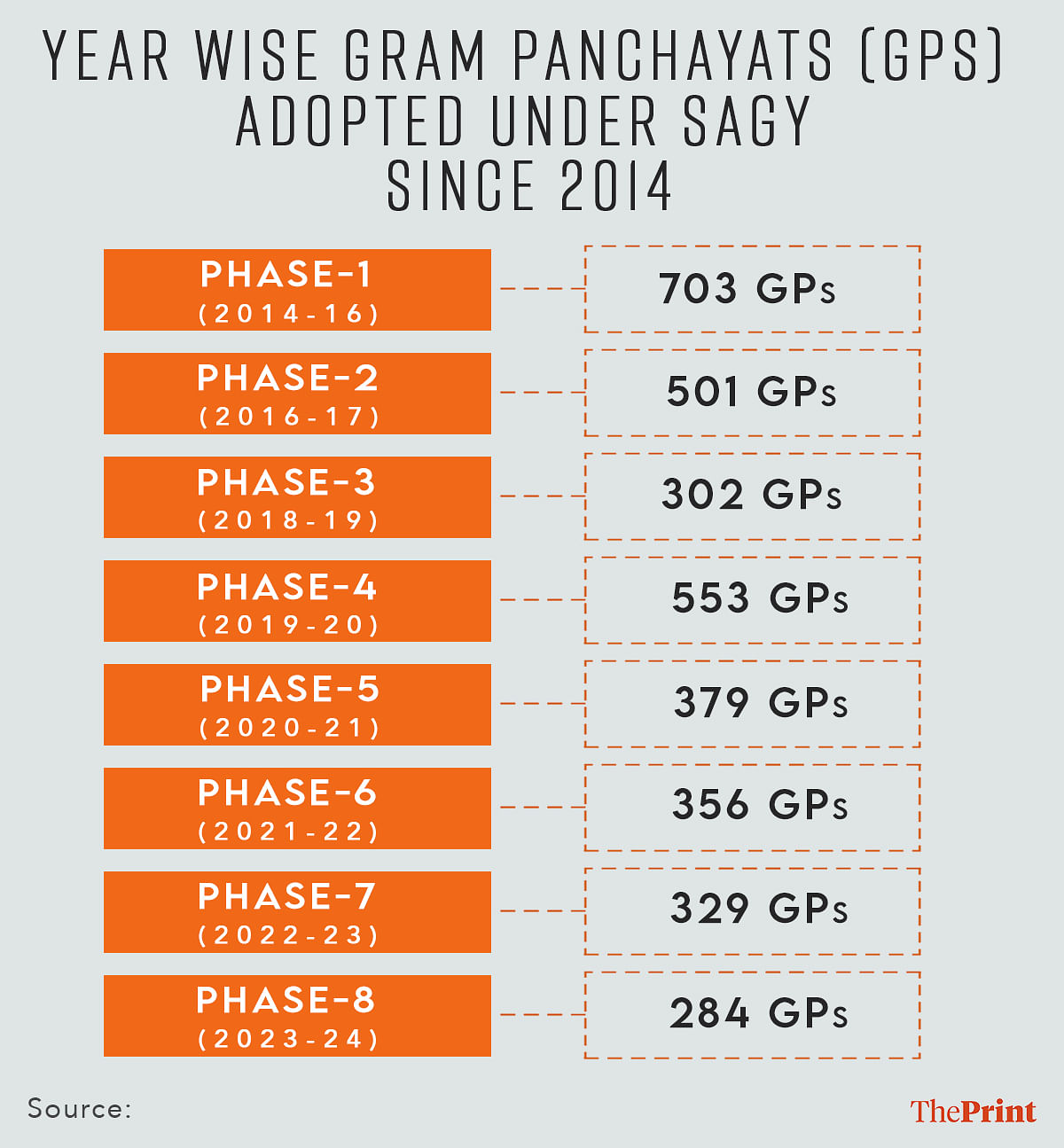
“Every day someone falls here. I am poor, I go to work to earn money. That does not mean I do not have dignity. If this is the situation in an adopted village then what can we say about the rest,” said Kumari, who has been living here for the past eight years.
The SAGY, one of PM Narendra Modi’s ambitious schemes, was launched in October 2014 on the birth anniversary of Jai Prakash Narayan. It was to inspire a movement towards good politics, with MPs acting as catalytic agents for ground-level change. In the initial years, the lawmakers adopted villages, but today MPs are finding it difficult to live up to the expectations the PM set for them in his first year in office. The adoption under SAGY has dropped by 60 per cent in 2023-24 as compared to 2014. Modi’s pet project has seen the adoption of only 3,406 GPs of the around 6,000 GPs originally targeted, just above the half way mark. Lack of interest among MPs, jurisdiction bottlenecks and above all the absence of dedicated funds are prime reasons for this poor response. The key indicator of the scheme sagging is that Modi himself has not mentioned SAGY from a public platform in a long time.
Between 2015 and 2022, there were 10 questions on the programme in the Lok Sabha, most of them asking about the success of the scheme and inquiring about separate funds. Nearly half of the questions have been asked by BJP lawmakers.
And BJP MPs have demanded separate funds. “The Prime Minister’s scheme is commendable but if separate allocation had been given for it, the villages would have been developed in a better way,” Gopal Jee Thakur, BJP MP from Darbhanga told ThePrint.
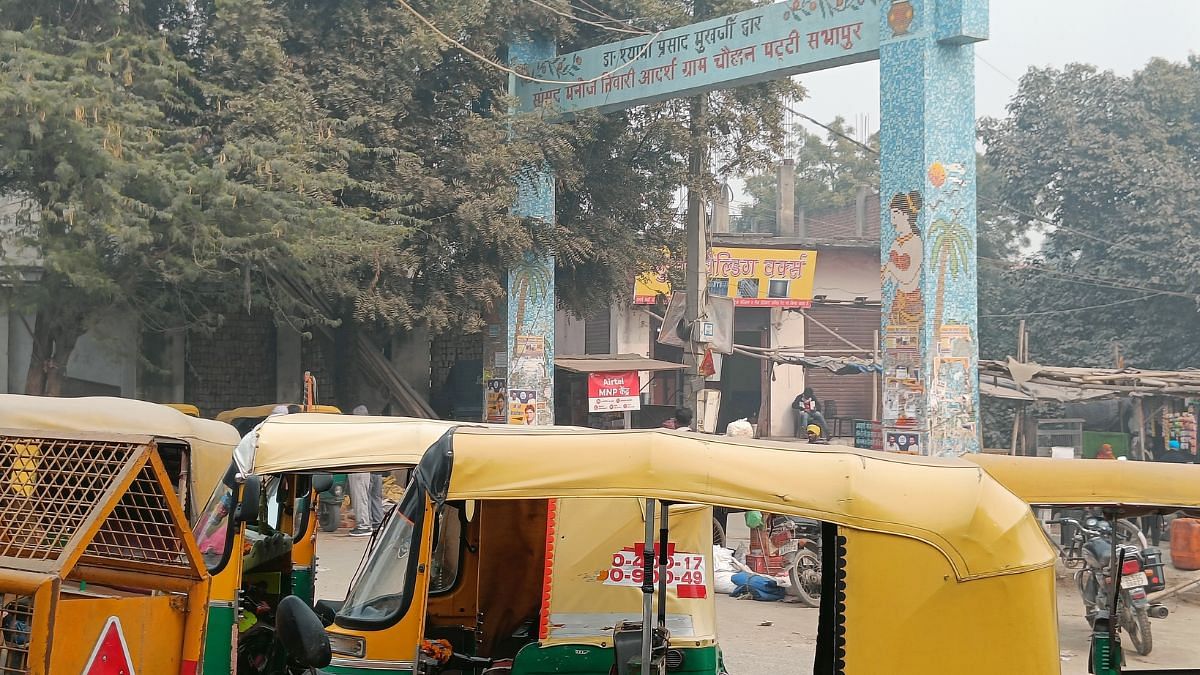
Also read: ‘Hindustan is finally for Hindus.’ Ayodhya Express reaches Ram temple
Funds crunch
Chauhan Patti residents were an excited lot when their village was adopted by Manoj Tiwari in 2014. In hope that Tiwari will change its face and fate, they felt privileged. Today they don’t even want to talk about it. There is a feeling of betrayal on the ground.
“The word ‘Adarsh’ has now become like a blot for us. When relatives come, they also make fun,” said Surendra Chaudhary, lying on his cot adjacent to the grand village entry gate named the Syama Prasad Mookerjee Dwar built under SAGY by MP Tiwari. There is a picture at the gate in which a woman is seen offering water to the sun.
“In Chauhan Patti, roads worth Rs 12 crore have been built in this village and many high mast lights have been installed and 300 meter overhead high-tension wires have been laid underground. We made development plans but the administration did not get permission to spend the money. But we will work diligently on this in the next six months,” said Anand Trivedi, BJP’s North-East Delhi vice-president and Tiwari’s representative who attends village meetings on behalf of the MP.
In 2014, Modi had clarified that SAGY was “not a scheme about money”. Its main objective is comprehensive development of rural villages through convergence of central government schemes and people participation. “The model of our development has been supply driven. Schemes are made in Delhi and Lucknow and are pushed further. We want to change it from supply driven to demand driven,” Modi had said during the launch.
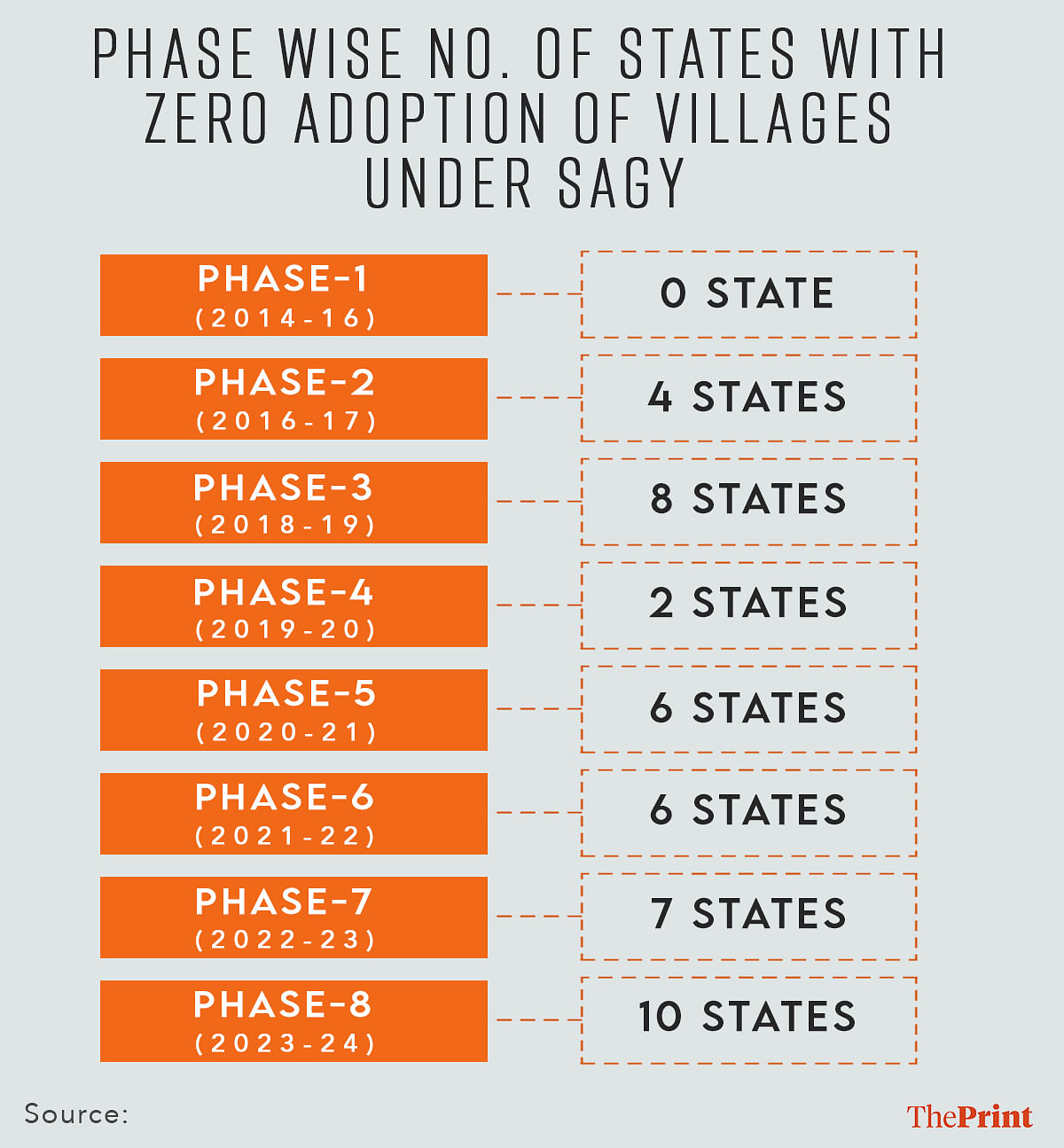
The plan made sense when the PM announced it, more so because it had his weight and word. That its implementation wasn’t thought through and in hindsight looks more like one of those poll promises that never see the light of the day is evident in numbers. According to SAGY guidelines, three GPs were to be developed by each MP by March 2019 and another five by 2024. But very few MPs from the Lok Sabha (543) and Rajya Sabha (243) have adopted eight villages so far. Under SAGY-1 (2014-19), 1,506 GPs were adopted. While in SAGY-2 (2019-24), 1,900 GPs were adopted.
In the first phase (2014-16), 703 GPs were adopted, which reduced to 284 in the eighth phase in 2023-24.
PM Modi, however, adopted eight villages in Varanasi, including Jayapur, Nagepur, Kakrahiya, Domri, Paramapur, Pure Bariyar, Pure Gaon and Kurhua. A lot has changed in Modi’s adopted villages. In Jayapur, which he adopted in 2014, there are banks, ATMs, skill academy, computer centre, regular power supply.
Former rural development minister Upendra Kushwaha admitted that the scheme is not working in the manner the government had anticipated. “The biggest challenge is the lack of support from the state governments. The district administration is not taking interest. If the state government helped, the villages could have developed well,” said Kushwaha, National President of Rashtriya Lok Janta Dal and who was in Modi cabinet during the launch of SAGY in 2014.
Another BJP MP, from western Uttar Pradesh, sees a political danger in this scheme. “If we improve one village, then people of other villages in our constituency will get angry with us,” he said on condition of anonymity.
As per data available on the rural development ministry website, in a large number of states and UTs, the percentage of work done in adopted villages is below 75 per cent. In November, the ministry asked state governments and UTs to expedite work and redraw development plans during a review meeting.
Kushwaha too blamed it on the lack of separate funds for this scheme. “If there were separate funds, work could have been done. Surely MPs would also be interested. But this was not known when the plan started. Later it proved to be a failure,” said Kushwaha.
Only 1,782 villages were adopted in the last five years. This means only 356 were adopted annually. However, total strength of MPs from both the houses of Parliament is 786. BJP has 393 MPs in both the houses.
There are 10 states and Union Territories where not even a single village has been adopted in 2023. These are West Bengal, Meghalaya, Nagaland, Ladakh, J&K, Delhi, Chandigarh, Andaman, Puducherry and Lakshadweep. In West Bengal, only one village has been adopted in the last five years. The BJP has 17 MPs in the state.
Since 2014, the number of such states is also increasing where not even a single village has been adopted. During the first phase (2014-16), villages were adopted in every state, while by 2023-24 this figure reached 10 states.
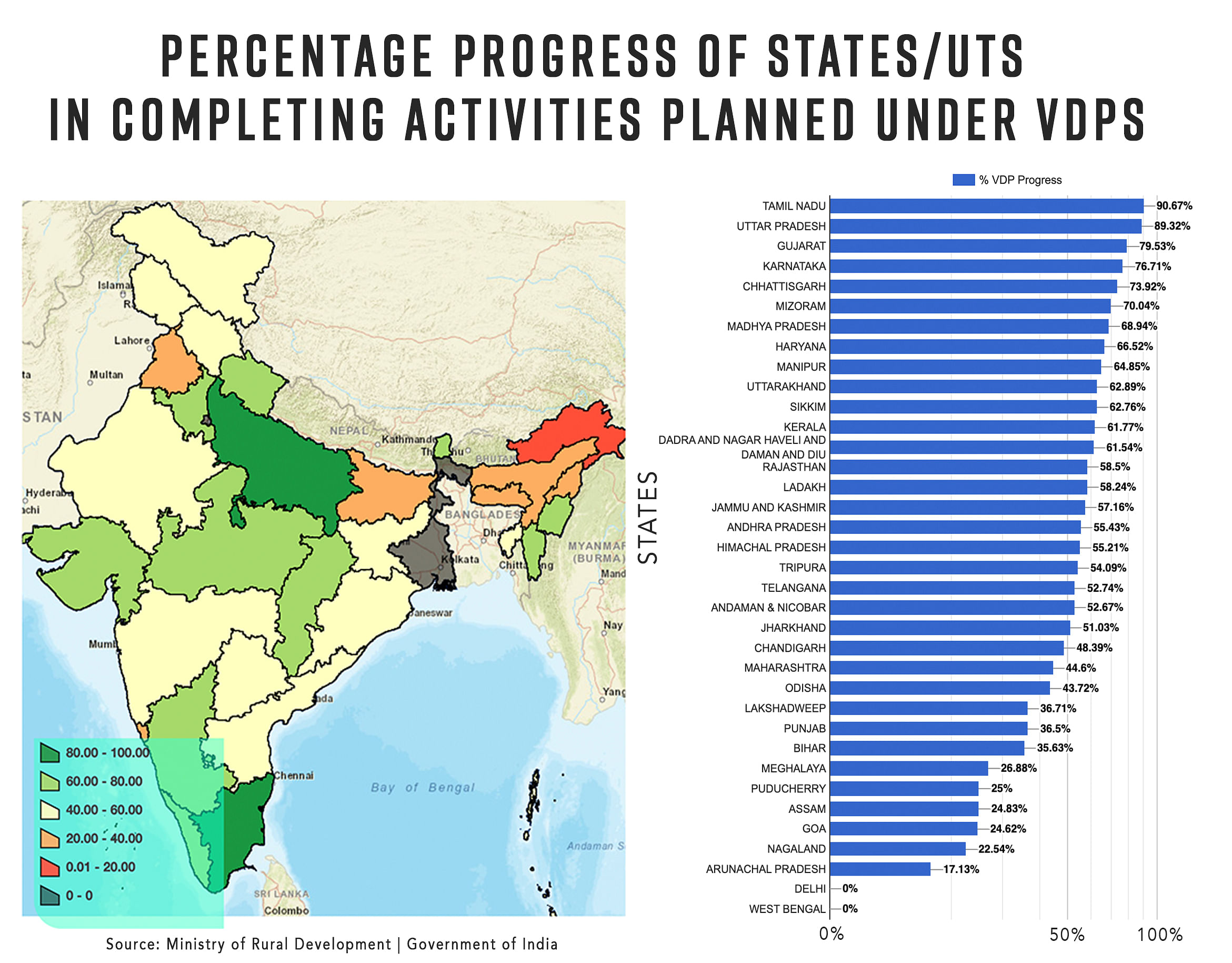
Also read: Royal, rich, Rajputi—Indian single malt whisky now global cool. A new culture being distilled
A Delhi village
The residents of Chauhan Patti have seen only two major changes—a grand entrance gate to the village and a bus terminal named after Pandit Deendayal Upadhyaya. But they don’t quite add up to the sum total of being ‘ideal’. The gutters still run over, trash piles up on every street and the roads are cratered.
Amit Kumar Choudhary, who sets up shop in the weekly market in the village said it feels like the rainy season all throughout the year. “There is filth and garbage everywhere in the village. Drains remain clogged and stray animals roam on the streets. Not an ideal village,” he said, pointing toward waterlogging spots and the potholes.
Tiwari adopted two villages in Delhi. One in Karawal Nagar (Chauhan Patti) and the other in Burari constituency (Kadipur).
In Delhi, jurisdictional overlap is being cited as the reason for stalling of work in adopted villages. Unlike villages of rural areas, in urban spheres, settlements are under municipal corporation. “Delhi government is not allowing work to be done in Chauhan Patti. Jal Board comes under Kejriwal and they are not allowing water connection in this area. But the MP has still got the bus terminal and some lights installed from the MP fund,” said Trivedi.
There is also the problem of oversight and jurisdiction.
DMs are the nodal officer implementing SAGY. They are supposed to have monthly review meetings with departments and heads of GPs. But there are no regular meetings held to review the progress. Residents said, no SAGY meeting has been held after 2019 elections.
According to Vikram Bisht, SDM Headquarters, North East Delhi, land availability is a challenge for development in urban spaces. “No progress is visible regarding Saansad Adarsh Gram Yojana,” said Bisht, who had recently spent a night with other officers in a village barely 1.5 km from Chauhan Patti and had to listen to the problems of the residents.
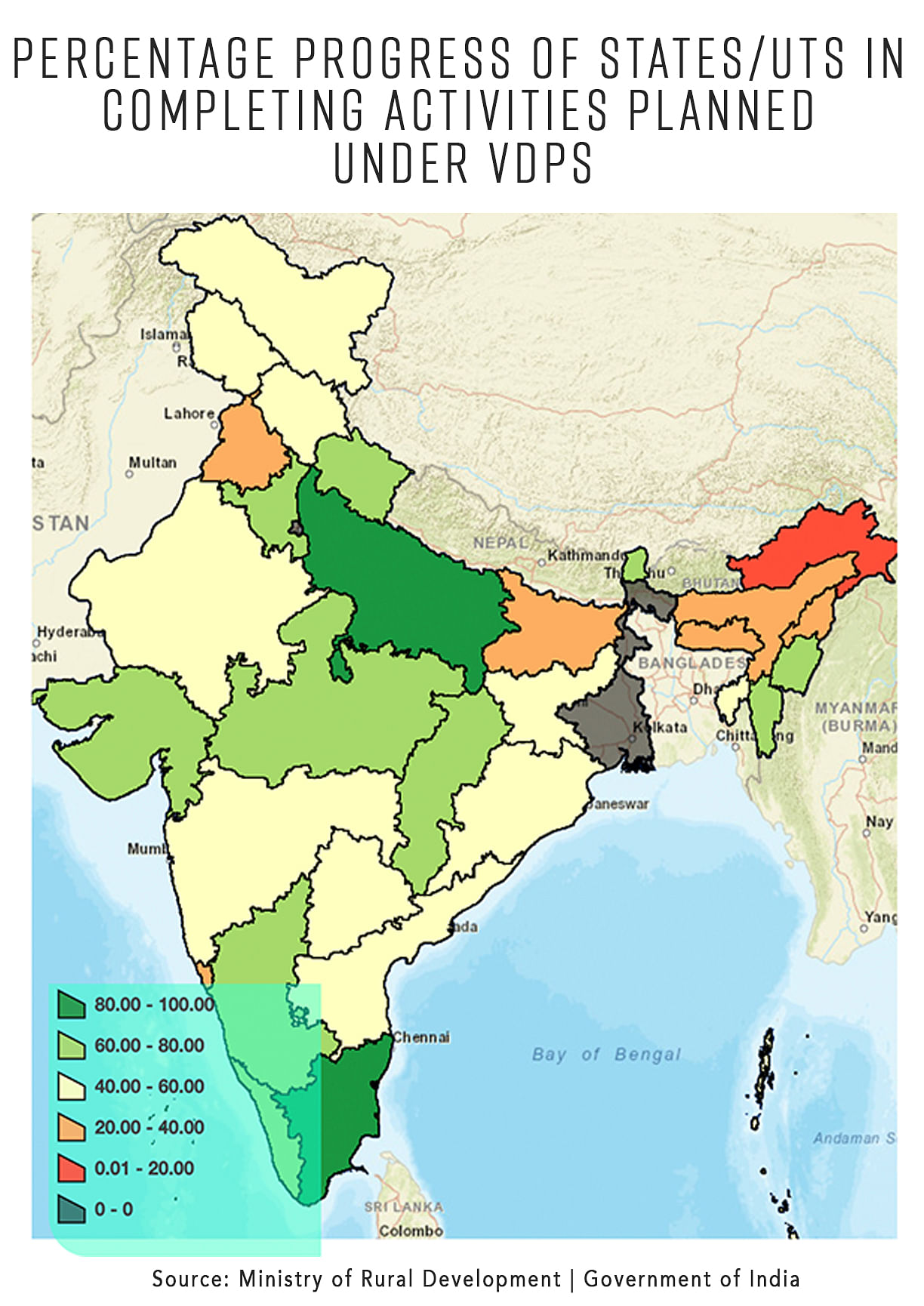
As per SAGY guidelines, MPs are required to engage with the village community and also prepare Village Development Plans (VDPs). But government data shows that out of 3,406 adopted GPs, only 2,968 have a VDP in place.
Ompal Tomar, a resident of Chauhan Patti, who was present with Tiwari in some of these SAGY meetings, said people’s views are not given due importance. “Role of people in the decision is negligible. And not much work has been done.”
In 2014, Manoj Tiwari adopted Kadipur village and made it the first wifi village of the country. It hogged headlines then. Now, there is no wifi internet here. Residents are disappointed with the civic infrastructure too. Not just internet connectivity, even road connectivity is poor. Reaching Kadipur is a big task as approach roads are dust bowls and waterlogging is a big issue. Only one government bus stops at this village.
The village has a very small population of Jats, Brahmins and Jheemars. Even though SAGY guidelines aim to reduce migration and increase employment opportunities, many Kadipur residents have migrated in search of a better life and employment.
“After adoption, only a few roads have been built in the last nine years. No major facility has been provided yet. There is a lack of health care and sewer lines are not yet there. Nor is there any community hall. Even the veterinary dispensary is in dilapidated condition,” said Harpal Singh Rana, resident of Kadipur who organises a weekly Harpal ki chaupal.
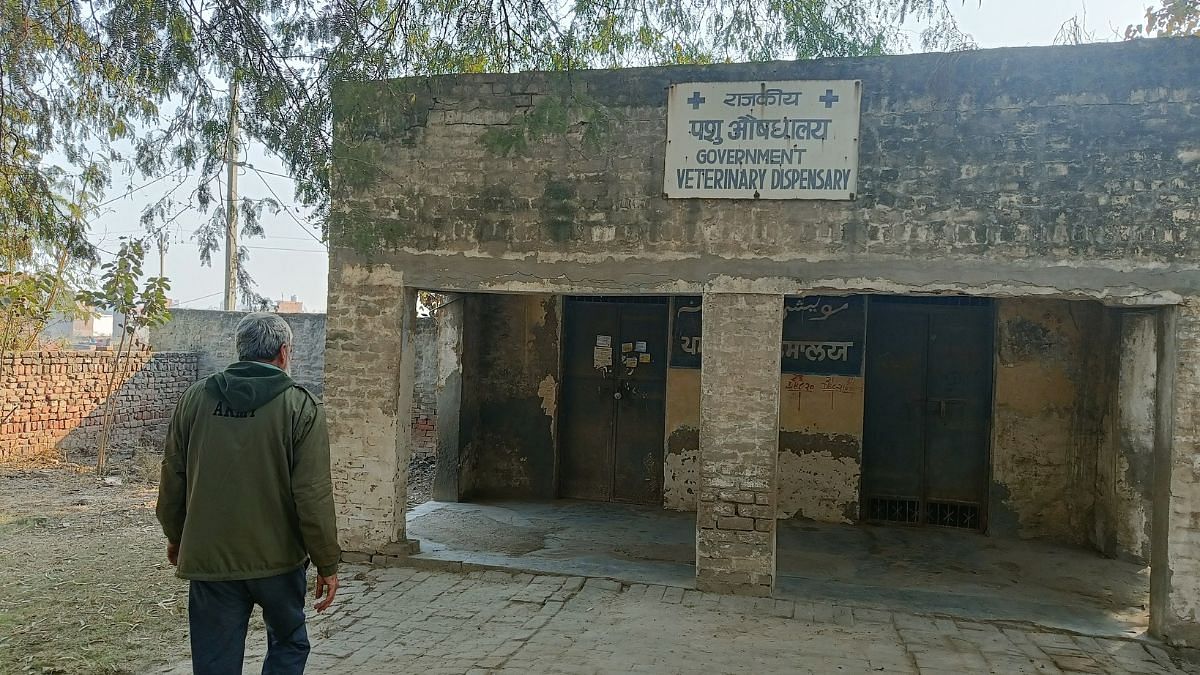
Urmila Rana, former BJP Councillor of Kadipur said that the lack of funds and the jurisdiction tussle between various agencies pose major challenge. “People think that all the work can be done by MPs and councilors, but we also have compulsions, that too should be understood. The work is done only as per the budget. AAP stubbornly did not allow the work to be done,” said Rana sitting in the chair in his big house—its exterior walls pasted with posters of Tiwari.
AAP councillor Munesh Devi, however, refuted these allegations and gave credit for the development works to the party MLA Sanjeev Jha from Burari. “Nothing has been done in the village in the name of Adarsh Gram. Not a single penny has been invested,” said Devi.
The SAGY guidelines also mandate reducing migration and increase employment opportunities.
“Many people have migrated from here. Either they have moved to another city or are living somewhere else in Delhi,” said Nirdosh Koshik, a resident of this village sitting in his car. Villagers also expressed their displeasure that Tiwari rarely comes to the village and even when he comes, he does not meet people.
Residents said three welcome gates, benches and sign boards giving directions were installed in the village. “Tiwari ji also has the pain of work not having been done. And we had to suffer the consequences of this in the elections,” said Rana.
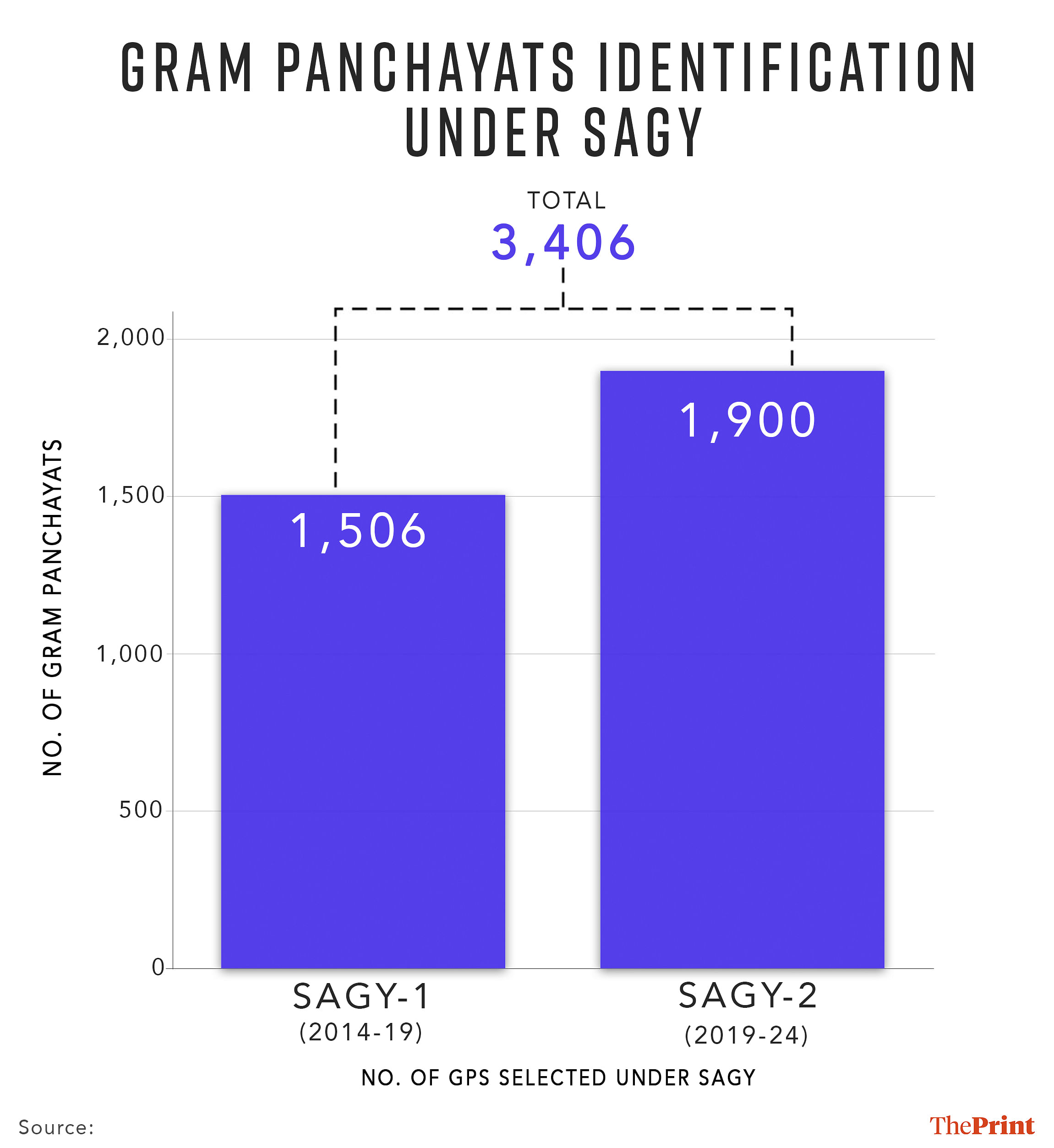
Also read: Gujarati Muslims struggle to buy Hindu property. Disturbed Areas law weaponises real estate
A UP village
While launching the scheme in 2014, Modi said there were a few villages that the states could be proud of and this shows there was something extra beyond government schemes. “This something extra is the spirit behind Saansad Adarsh Gram Yojana.” Modi’s was a call to lawmakers cutting across party lines and many non-BJP leaders obliged.
In 2019, Sirswan Gaur, Sarai Khajoor and Korwaku villages were adopted by Samajwadi Party MP S.T. Hasan in Moradabad, 170 km from Delhi. Many residents of Muslim dominated Sarai Khajoor, about 16 km from Moradabad district headquarters, have no knowledge of their village being adopted. It has a population of around 8,000 and most residents are farm and wage labourers.
Under SAGY, the villages having 3,000-5,000 population in plain areas and 1,000-3,000 in hilly, tribal areas can be identified as a suitable GP.
Sitting on a cot in the courtyard of his house on a cold January evening, Mohammad Intezar is waiting for vikas to arrive in his village. “The roads are full of silt. People are in trouble. If he (ST Hasan) hasn’t done anything yet, what will he do now? Now the code of conduct is going to be imposed,” said Intezar.
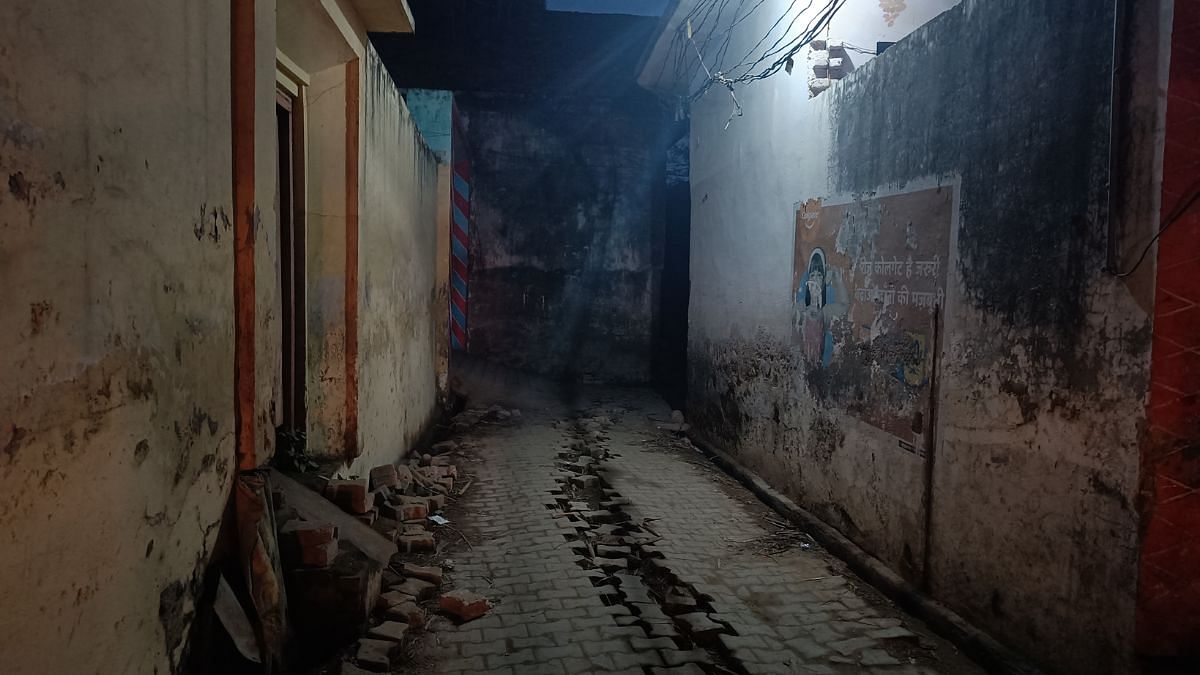
Intezar demanded a sewer line, veterinary hospital and an Anganwadi in his village. “It becomes very difficult to come to this village during the rainy season. Roads have not been repaired for the last 20 years. There is no hope left now. People are angry with the MP,” said Intezar smoking beedi.
65-year-old Veer Singh is a resident of Siraswan Gaur village and is often worried about the plight of his village. Sipping tea, he said, after becoming MP, Hasan Saheb did not even pay attention to the village. “Development should be such that every person remains happy. He adopted the village but has not been taken out of his lap.”
A Muslim dominated Siraswan Gaur has a population of 7,500. But no high school. To access health facilities, one has to go to Moradabad, 30 km away.
“Everyone was happy when the adoption took place but now no one wants to even discuss it,” said Roop Singh, head of Siraswan Gaur village.
Between 2019 and 2022, 179 GPs have been adopted in Uttar Pradesh. It shows that out of 80 MPs from UP, not everyone adopted a village every year.
Moradabad MP ST Hasan said that this scheme is only defaming the MPs that they are not working. “Adarsh Gram scheme should be stopped. This is just dramebaji and jumlebaji.”
Hasan has raised questions in media regarding this scheme many times before. The MP said that under the scheme, no meeting is held at the district administration level. “This is just limited to paper. Unless separate funds are provided under this scheme, its condition will remain the same.”
A senior official in Moradabad district administration said that there seems to be aloofness regarding this scheme. “Budget shortage is the biggest challenge. We can only give the benefits of the schemes coming from the state and Center to the public,” he said on condition of anonymity.
Also read: This Indian watchdog is cleaning up ‘mess’ in academia—falsification, fabrication & fraud
A ‘non-starter’
With India’s urban centres having witnessed massive infrastructure growth in the past decade—from metros in tier II cities, to a network of flyovers and emergence of satellite towns—the country has set clear its developmental path. But a key indicator that Bharat has been left behind is the neglect of these adopted villages.
According to a 2020 audit report by Common Review Mission (CRM), SAGY has been a non-starter. “As such these villages cannot be called model villages. The CRM is of the opinion that in the current format, the scheme is not achieving the desired purpose. It is recommended that the ministry may review the scheme for enhancing its impact,” the audit report stated.
“The SAGY GPs have shown mixed results in terms of the extent of its success, but is nevertheless a scheme worth continuing with and focus should be on efforts to transform GPs to self-sustaining institutions. The spirit of SAGY goes beyond physical projects being completed,” according to a report on post-project evaluation study of SAGY in Gujarat and Rajasthan by Sardar Patel University.
With the Lok Sabha polls just a few months away, people at these adopted villages know their leaders will show up soon. Questions about Adarsh gram will bubble up. But residents say there are other factors in voting.
“He (Tiwari) is winning only in the name of Modi,” he said.
(Edited by Anurag Chaubey)


